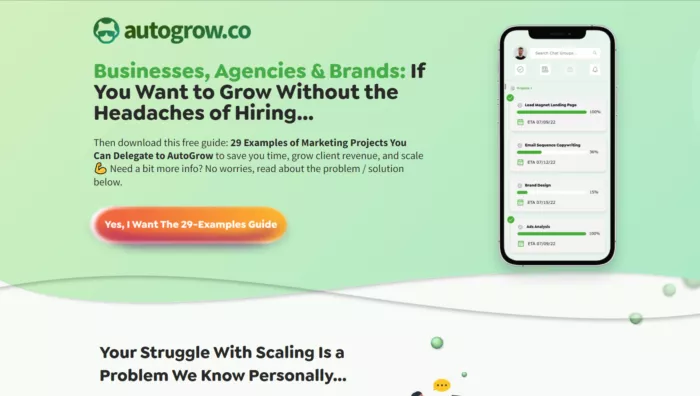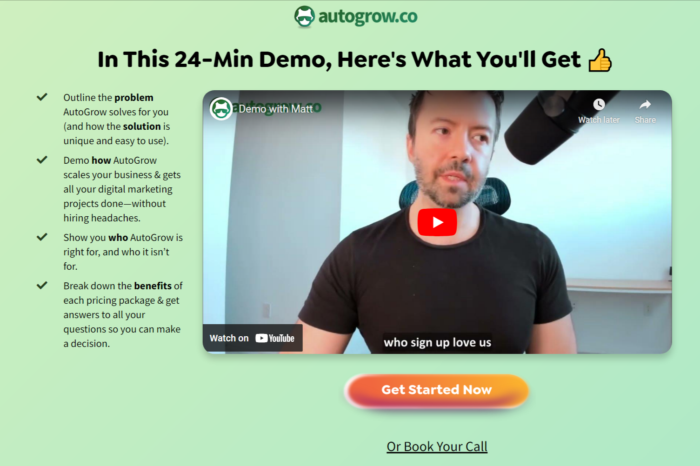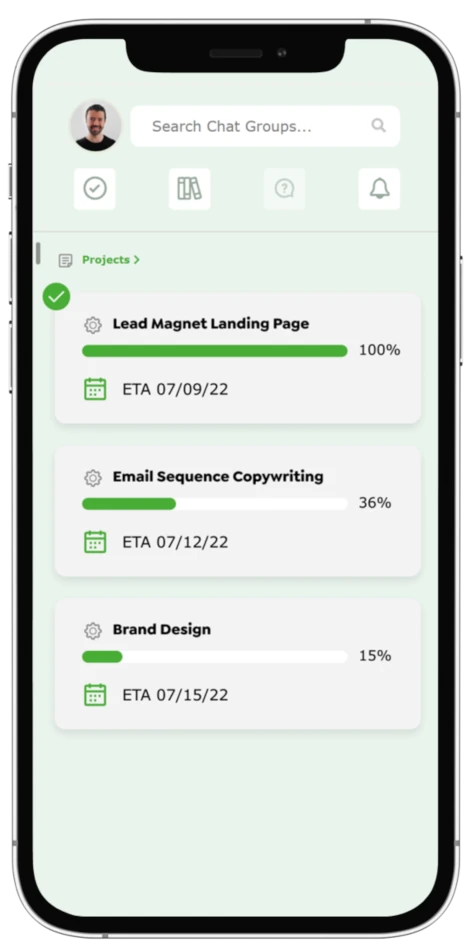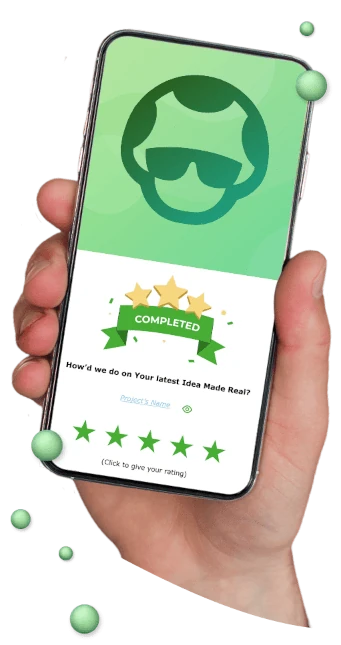How to Create Your Email Marketing Funnel in a Snap

“Are we there yet?”...
Raise your hand if you were ever obnoxious enough to ask this over and over again in the car when you were a kid
I certainly was.
This was one way I’d entertain myself on those long boring road trips when my family would go on vacation (and when my Gameboy’s battery power ran out).
My “conversion goal,” so to speak, was to get a reaction from my parents.
And I was often successful.
Usually, it was a “You JUST asked that question, we’re still not there yet”...
But still, a reaction’s a reaction .
Now, an email marketing funnel works in a similar way. Except, instead of nagging your potential leads with email after email, you’re nurturing the relationship with them.
You’re giving value rather than being obnoxious.
That’s what an effective email sales funnel does.
And when you know how to do it correctly, you can convert more subscribers into clients or customers than through any other marketing channel.
In today’s resource, you’ll learn:
- What an email marketing funnel is—and why it’s money down the drain if you aren’t already using one.
- The 6-step proven email sequence formula with proven results (and that you can copy today).
- And a few advanced techniques you can apply to your funnel to boost conversions and offer more personalization.
You can get things set up and running in just a few hours (if you do it right). So let’s start from the beginning…
What Is an Email Marketing Funnel?
You may have heard of the term email sales funnel before. Or maybe you’ve heard it called one of its many other names:
- Autoresponder
- Email sequence
- Nurture sequence
- Automated email follow-up
- Follow-up sequence
Lots of different labels, but really, they all describe the same thing.
So the question is, what is the definition of an email sales funnel?
An email marketing funnel is a series of emails with the goals of:
- Nurturing a relationship with an email subscriber.
- Educating a potential customer on the benefits of a service or product (or about the problem you help solve).
- Nudging them to make a purchase decision.
A simple email marketing funnel might look like this:
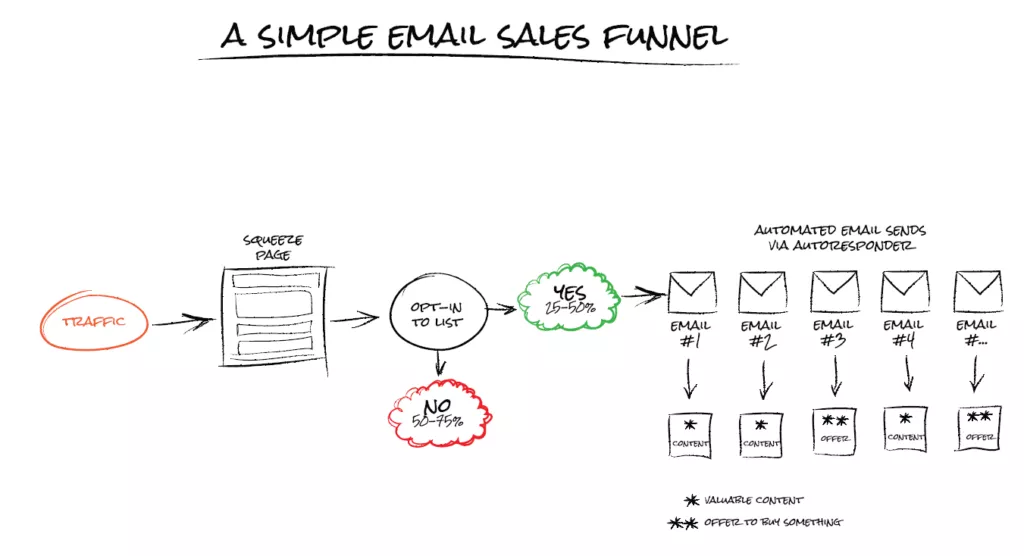
With email marketing automation tools like ActiveCampaign, you can even tag contacts based on actions they take (or don’t take) on your website. Like for example, based on which type of lead magnet they opt in to.
That way, you can personalize the content they receive and improve conversion rates even more (because personalization really sells).
In fact, when we started “bucketing” our opt-ins (survey funnel) and personalizing our content a few years back, we saw email subscriber engagement increase by over 200%.
And you can even do lead scoring depending on an email contact’s level of engagement.
But wait, wait… I’m getting ahead of myself here.
We’ll discuss these more “advanced” tactics a bit later.
But for now, let’s just take a look at why you need an email marketing funnel and what you need to start building it today.
And afterward, I’ll show you how you can boost your conversions even higher.
Okay, Why Should You Care About an Email Marketing Funnel, Though?
If you’ve done even a little research on email marketing, you probably already know the answer to this question.
In a nutshell, you should care about this kind of funnel because email is the superstar of the marketing world.
Here’s why:
People stop and read their email more than any other marketing channel.
Sleep Advisor found that nearly 1 out of every 9 Americans will check their email immediately after waking up. On top of that, a whopping 60% of people will do the same within an hour after waking up.
It’s clear that people love checking their email, but what about engagement?
Well, OptinMonster actually found that email has significantly higher engagement, even than social media.
Like almost 6.5X higher engagement.
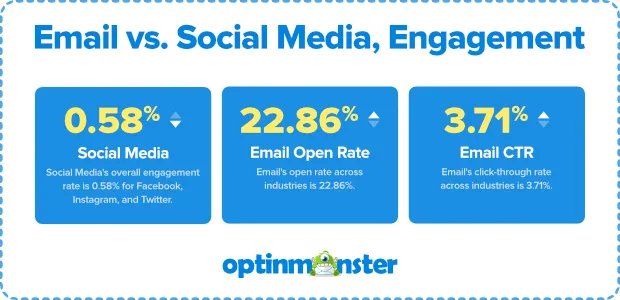
Plus, email allows for greater personalization of content (which is partly why people check their email so religiously in the first place).
And that personalization is great news for marketers because that means they can boost their conversions even higher.
As you can see from the results below from an Upland Software study, marketers found that there are some huge benefits that go along with greater email personalization.
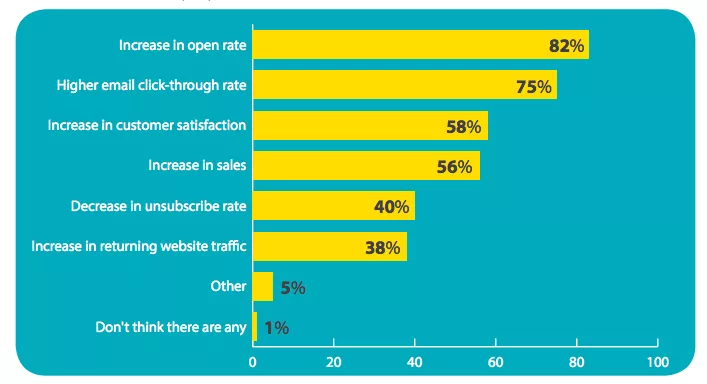
Higher open rates are, of course, one of the most important results.
But it’s also worth noting that more personalization also means a higher CTR, greater customer satisfaction, and ultimately more sales.
And last but certainly not least, all of these benefits to email marketing add up into a significantly higher return on investment.
How much higher you say?
Well, there are quite a few numbers out there.
Some sources like OptinMonster say that ROI can end up being as high as 4,400% (that’s $44 for every 1$ invested).
Others tend to be a hair more conservative like Litmus, who found the ROI was closer to 3,800%.
But in either case, it’s worth noting that this is substantially higher than virtually every other marketing medium.
Check out how much higher…
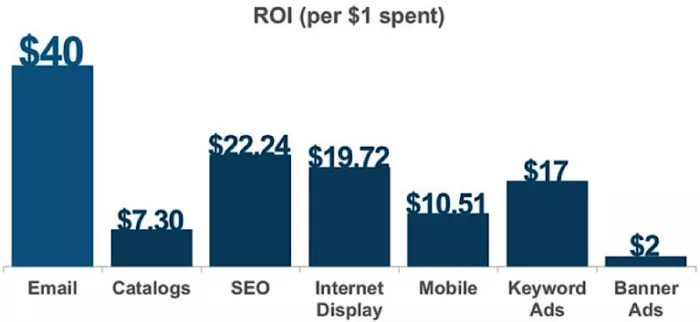
As you can see, email marketing has quite a lead over every other type of digital marketing.
And most marketers know it too.
In a recent study from eConsultancy, more marketers gave email marketing the highest rating for ROI than any other marketing channel—higher even than organic search engine optimization (*gasp!*).
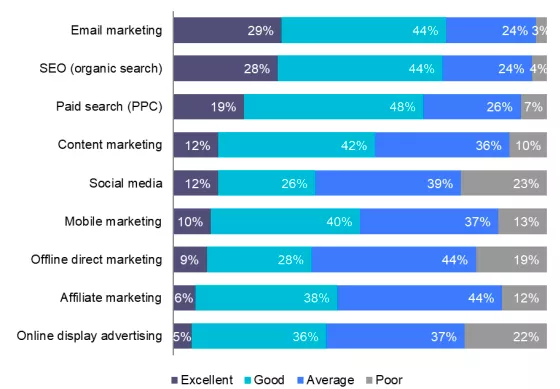
And last but certainly not least, you actually own your email list.
While subscribers on social media are great, you’re really at the mercy of the platform.
What if it goes under? What if it changes its algorithms and rules? What if your hard-earned list of 50,000 contacts is decimated overnight because of a single marketing decision?
No thanks.
With an email list, you are the one in control. And that means the power to use that list well is entirely in your own hands (hey, it’s a good thing!).
Alright, alright—enough about the benefits of your email marketing funnel.
Let’s get to the meat: how to set up your own email marketing funnel.
Getting Started: Preparations for Your Email Marketing Funnel
Now, if there’s a single thing that every type of funnel has (whether it’s an eCommerce funnel, an online course funnel, a coaching funnel, a SaaS funnel, an agency sales funnel, or any other type), it’s that a funnel needs traffic.
After all, how are you going to convert people on your offer when no one’s there when you present it?
And an email marketing funnel is no different. It needs subscribers in order to work.
So, where do you get those subscribers?
Well, there are actually tons of different strategies you can use to build your email list.
But in general, the 3 easiest and most effective strategies are with newsletter opt-in forms, lead magnets, and webinars/demos.
Newsletter Opt-In Forms:
This is probably the simplest of the 3 to implement.
Just slap a form right on your website and wait for the subscribers to flow in.
Simple as that.
It’s what we do right here on the articles section of our website.
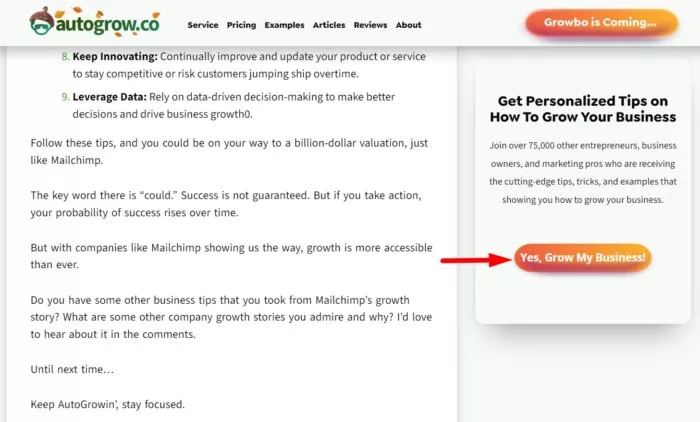
Including opt-in forms on your blog and throughout your entire website follows what I like to call the “Every Page Rule.”
Essentially, this rule states that in order to get the highest rate of conversion possible, you should treat every page (eh?) like a landing page.
That means every page should have a CTA. Every page should in some way or another try to push your audience towards taking action. And every page is a marketing opportunity.
So even your blog, your about page, or your careers page should have some sort of CTA.
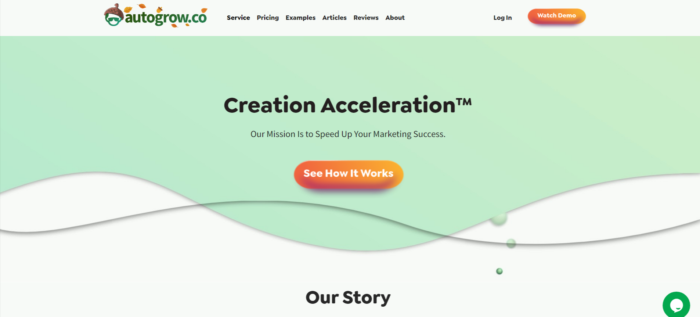
And including opt-in forms regularly is a great way to adhere to that rule.
But beware: your audience has got to actually love the content you’re putting out.
Because if they don’t, they won’t have any reason to subscribe to your list in the first place.
You’ve got to offer value in the form of releasing consistent, quality content on your blog or website.
Lead Magnets:
One alternative to newsletter opt-in forms is offering immediate value up front with a lead magnet.
A lead magnet is basically any form of free and valuable content you offer your audience in exchange for their contact info (usually an email address).
They can come in a super wide variety of forms too. Some of the most popular are:
- Checklists
- Guides
- eBook
- Reports
- Whitepapers
- Case Studies
- Templates
- Swipe Files
- Tutorials
- Toolkits/Resource Lists
- Video Training
- Quizzes/Surveys
Again, the key is to offer value.
The more valuable your lead magnet is, the more likely people will be to hand over their email and click the download button.
It’s also important to explain that value by driving visitors to a unique landing page.
Here, visitors can learn more about your lead magnet, see how it relates to their business/life, and decide whether or not to download it.
Think of it like a shorter sales page.
We build out a unique landing page for each of our lead magnets just like the one above.
And with tactics like this, we’ve been able to grow our subscriber base to well over 75,000.
Webinars/Demos:
Finally, there’s the webinar/demo option.
If you are in a place in your business where you can start teaching others how to solve some type of problems, then getting on a webinar can be one of the best choices you make for your business.
You can even automate your webinars to make things even easier.
Additionally, if you have a service or product that isn’t self-explanatory, putting a demo video on your website can be a great way to boost your conversions.
But in either case, gating this content by requiring a name and email address is a fantastic way to build your email list and fuel your email marketing funnel.
And again, it’s what we do on our own pages too.
Check it out below.
All it takes is adding a simple pop-up to your CTA button.
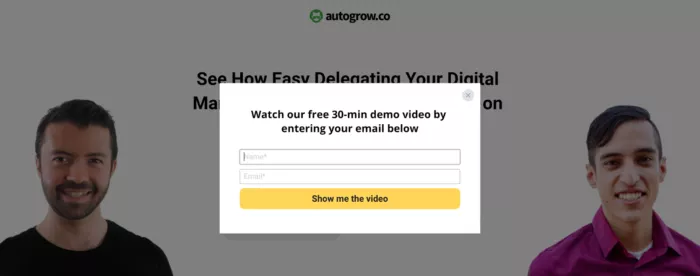
Then, just sit back and watch your email list grow and grow.
The VACUUM Formula: AutoGrow’s Proven Email Marketing Formula
Now that we’ve covered how to fuel your email marketing funnel, let’s look at what to actually include in your emails.
Over our 13 years of being in business, we’ve perfected an email marketing formula that builds trust quickly and maximizes conversions.
We call it the VACUUM formula.
It’s what we use for our clients. It’s what we use for ourselves. And it’s my professional recommendation that you start using it too.
Here’s how this proven email marketing formula works.
Each email has a single goal represented by a letter in VACUUM.
- V – Value (give your readers value)
- A – Authority (show why your subscribers should listen to you)
- C – Call-to-Action (get your readers to act on your offer)
- U – Unique (show your subscribers why you stand out from the other guys)
- U – Urgency (tell your readers why they should act now)
- M – Make a Decision! (give a final hard push for the sale)
Now, when you’re first starting out, I suggest building out the first 3 emails and launching from there.
These 3 emails are enough on their own to build trust and authority and then inspire people to act.
After you start seeing results, you should then (and only then) start building out the second half of the formula.
Now, let’s take a closer look at what each of these emails might look like and what kind of content you should include.
VACUUM Email Formula #1: Demonstrate Your Value (Why Should Your Subscribers Care?)
Your very first email should aim to provide value to your subscribers.
So put your salesman hat back on the hook for a while. Because more than anything else, you want to reassure your leads that they made the right choice, not that they’re just going to see a barrage of sales pitches.
After all, many have just opted into your newsletter or have just heard about you through your lead magnet.
They may be a little aware of you and your services. But they sure as heck don’t want to be sold to right off the bat.
So instead, take this opportunity to build trust by pointing them to valuable resources they can use.
Blog posts, tutorial videos, guides, ebooks—whatever you can do to help them learn more about their problem and the solutions you offer (without hard-selling), the better.
Apple’s emails are a great example of showing a variety of content in their emails.

DirectTV, Apple Arcade, Hulu—there’s a smattering of options to engage with here.
And in fact, that screenshot is actually a shortened version of the original email which I cropped out. The much longer version also includes engagement options for:
- Watching the NBA
- Learning more about Showtime’s Homeland
- Playing Minecraft
- Checking out the addictive Crossy Road
- Downloading the Formula 1 Racing game
- Or hopping in the virtual cockpit in Alliance: Air War
What Apple accomplishes here is it’s showing the wide variety of entertainment options available through iPhone, iPad, and Apple TV.

And you’ll notice that not a single link has to do with selling their own products (though they’re all accessible through them).
Peloton does something similar by offering their subscribers articles on how to stay healthy.
Healthy breakfast options, stretches, and fitness apps are all highlighted along the way too.
It’s just one more example of a great email that’s only focused on offering subscribers value.
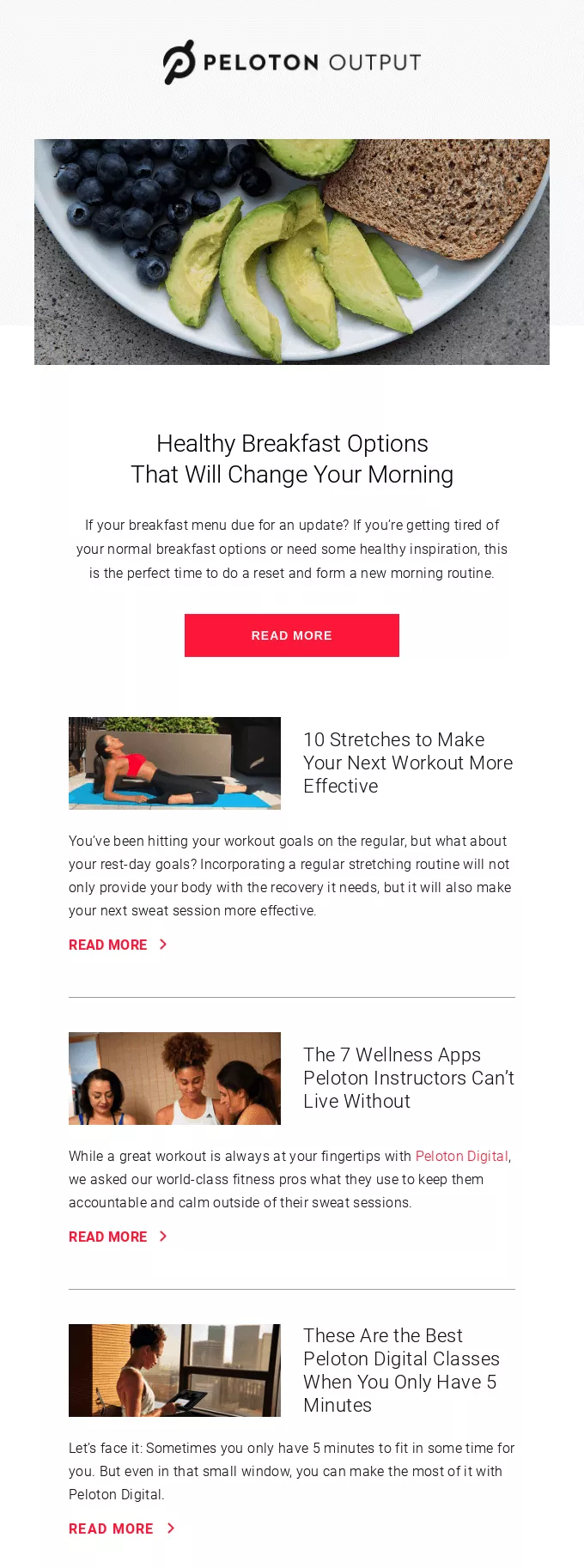
VACUUM Email Formula #2: Prove Your Authority (Why Should Your Subscribers Listen to YOU?)
Your next email from your VACUUM formula should be focused on establishing yourself as an authority.
Why should your subscribers trust your judgment? Why should they listen to you at all?
This email should answer those questions primarily by providing a range of social proof.
Social proof is showing your audience that you are a company or an expert whose product, services, or advice should be trusted.
And as any marketer knows, it’s an incredibly powerful tool when convincing your audience to buy.
Now, social proof can come in a variety of forms.
For instance, it can be conveyed through testimonials like in the email below.
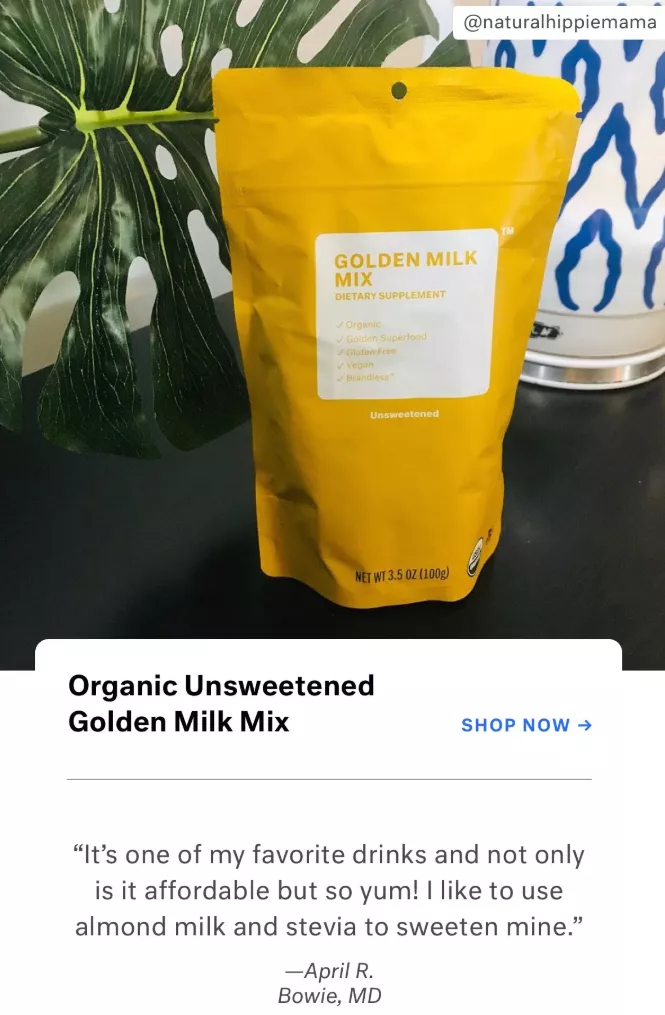
Since this testimonial is coming from another real live customer, prospective buyers trust that opinion more than just a marketing blurb written up by the company itself.
Plus, when you factor in the added credibility of this customer being an actual medical doctor, this one testimonial has some serious authority-boosting power.
Social proof can also come in the form of vanity statistics.
These are numbers and statistics that prove a company knows what they’re doing.
We use vanity stats right on our homepage to help establish our credibility.
See?
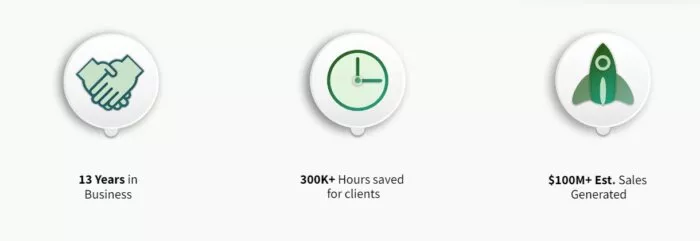
And you should do the same right in your second email too.
For example, check out how BarkBox uses the vanity stat of having served over 2 million dogs in their email to help boost their authority.
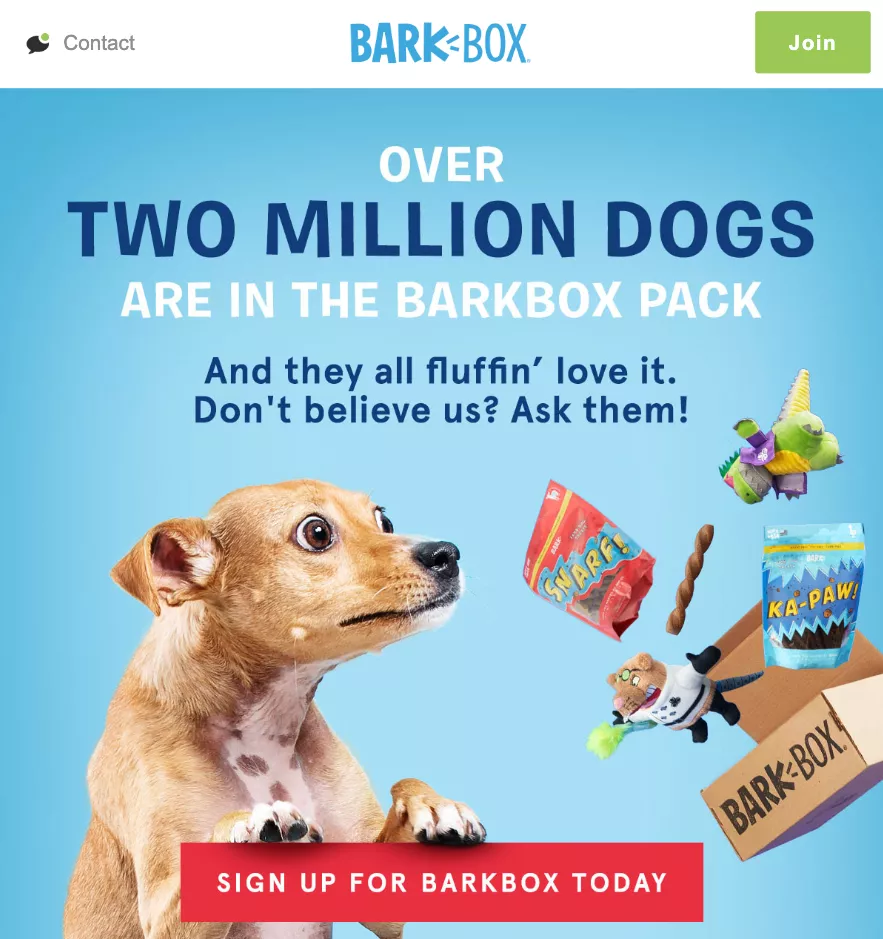
VACUUM Email Formula #3: Call-to-Action (What Do You Want Your Subscribers to Do?)
Alright, now that we’ve nurtured your subscribers with email #1 and established your authority in email #2, it’s time to make the sale.
This email should be focused on getting your subscribers to take immediate action on your offer.
First and foremost, that means including a super clear and super easy-to-find CTA button within your email. That’s marketing 101.
But beyond that, you’ll also want to use in this email what are called “power words.”
We’ve talked about these words a bit before. A few worth mentioning are:
- Imagine
- Because
- Actually
- Introducing
- Guarantee
- Free
But hands down the best power word has got to be “you.”
People love thinking about themselves. They love hearing about themselves. And they love talking about themselves.
So when you put the focus on the subscriber, you can drive serious conversions and serious action.
This email from Emma does a great job of including tons of “you” language.

Another tip for the CTA email worth noting is to make things simple.
Don’t overdo it with ultra-lengthy copy. Don’t make your subscribers scroll down and down and down to get to your offer. And ultimately, don’t make them work harder to take action.
Check out this CTA email from MeUndies to see how simplicity is done right.
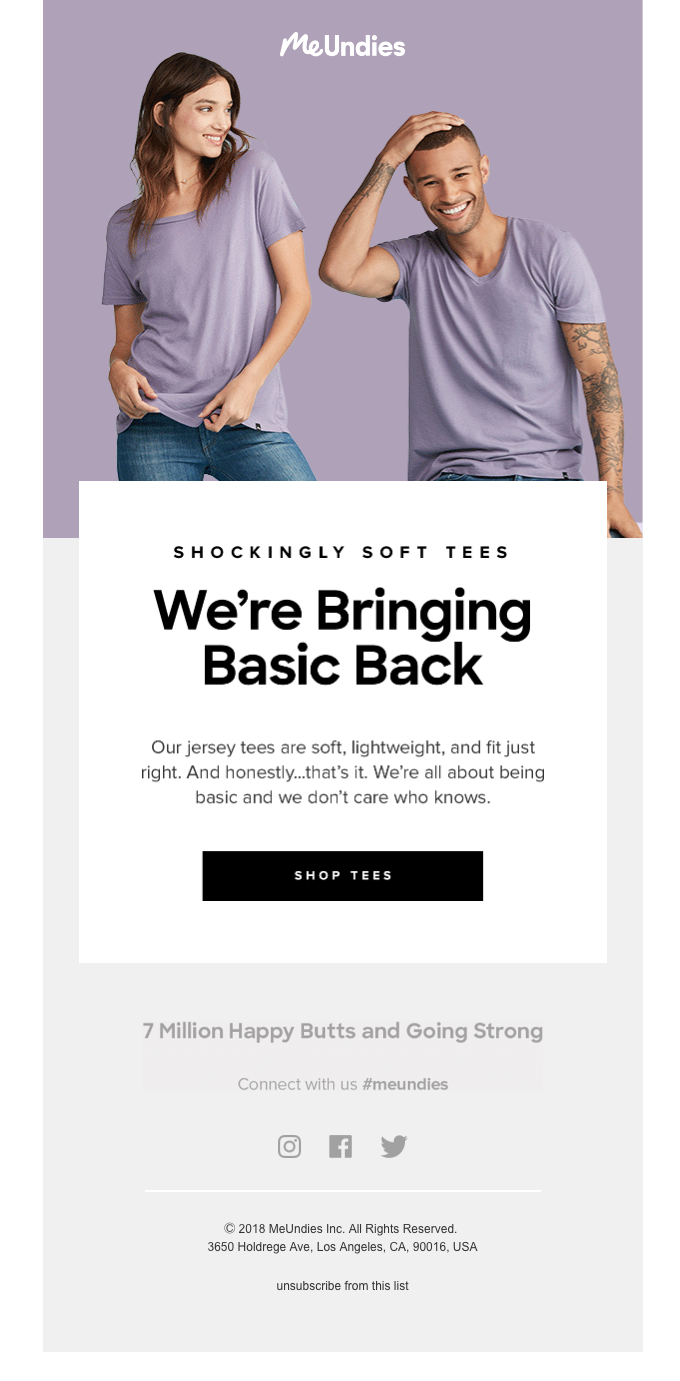
VACUUM Email Formula #4: What Makes Your Product/Service Unique?
Email #4 marks the turning point to adding emails that aren’t required, but can help boost conversions.
Now that you’ve set up your core email marketing funnel with your first 3 emails and have started seeing results, it’s time to take the next step.
In this email, the goal is to point out what makes your service unique.
Why do you stand out from your competitors?
One way of communicating that is by using language that actually calls out the fact that you’re different.
This is the “Us vs. Them” approach.
And when done well, it can be a powerful way of convincing your audience that your product or service is the right choice.
Check out this email from Rock Candy Media to see how to use the “Us vs. Them” approach effectively.
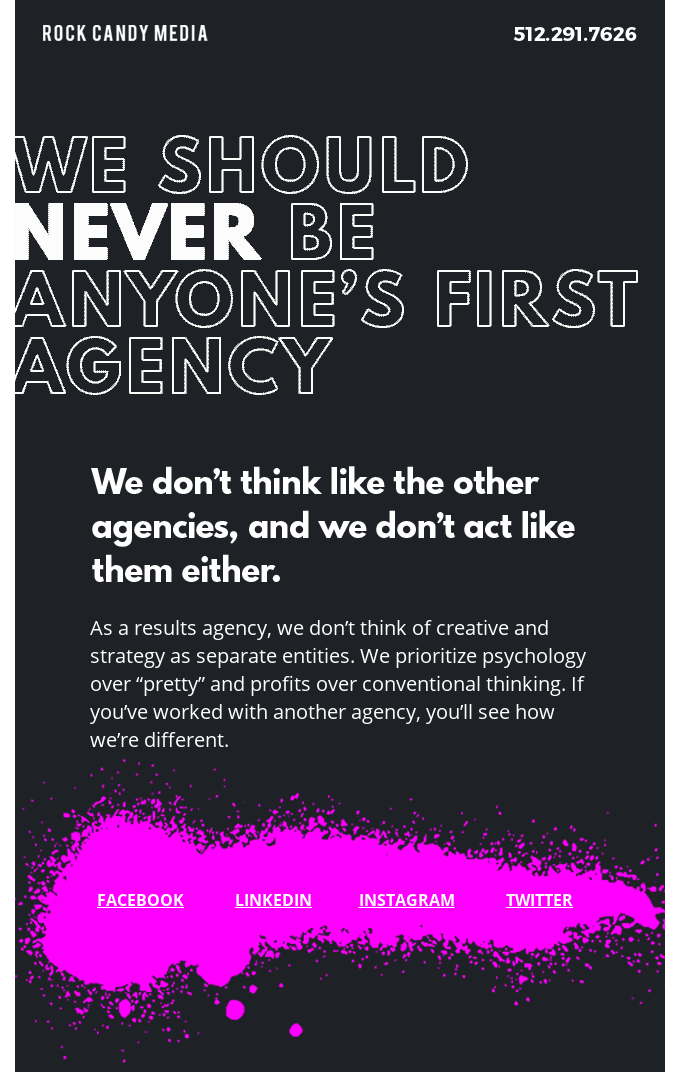
While the “Us vs. Them” approach can certainly work, one of the best ways to separate yourself from the pack is by pointing out your core values and unique value proposition.
What does your company stand for?
Why did you decide to create your unique products or services?
One example of setting yourself apart based on values comes from Scratch, a dog food delivery company.
Check it out below.

See how there’s a lot of focus on freshness, quality ingredients, and health? And see how they contrast that with many of the other major dog food producers out there?
With this kind of messaging, we understand that this is a brand focused on dog health. So you can rest easy knowing your pup isn’t eating overly-processed and unhealthy food.
It’s also worth noting that this brand’s main seller is its “kangaroo” recipe.
And yes—they mean real kangaroo.
Here’s a blurb from their page:
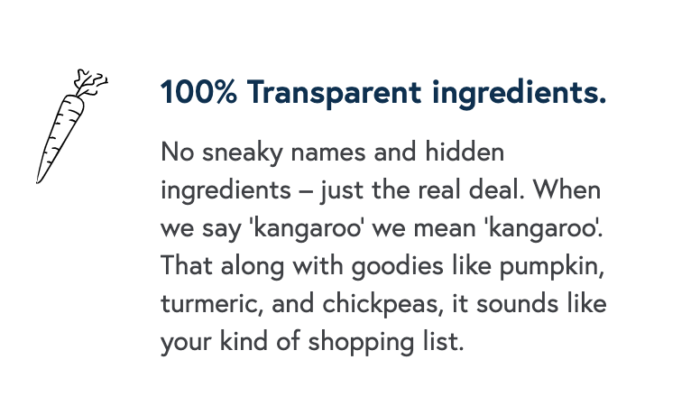
And if that doesn’t score points for uniqueness, I don’t know what will ;)
VACUUM Email Formula #5: Give Your Offer a Bit of Urgency (Or Scarcity)
In this email, it’s time to take things up a notch.
Because in email #5, your focus should be on conveying a sense of urgency.
And one of the best ways of doing that is by pointing out a limited-time sale to your subscribers.
Be sure to really light the fire under their butts by mentioning the date the sale is going to end.
Additionally, you can also make use of a ticking clock timer that’s constantly counting down.
Check out how reMarkable does just that in their Black Friday sale.

While a ticking timer is a great example of scarcity, it’s not the only way to use urgency to your advantage.
Because urgency’s cousin, scarcity, is another way to get your subscribers clicking your CTA.
“Limited supplies” or “first-come first-serve” are a few key phrases to include when trying to convey scarcity.
Check out how Bellroy really communicates scarcity well below.

VACUUM Email Formula #6: Make a Decision Already! (Time for the Hard-Sell)
And last but not least, it’s time for the hard-sell!
This is where you should pull out all the stops.
You’ve spent the past 5 emails building trust, establishing authority, and showing your subscribers why you’re the obvious choice: now it’s time to make the sale.
In addition to all the proven sales strategies I’ve talked about before, there are 2 other tactics that you should try out in this email.
The first is offering a “can’t-pass-it-by deal.”
It’s time to put your best foot forward and push subscribers on the fence to click “buy.”
Here’s an example of how to really show off your deals in this email.

Yeah, yeah, yeah—another Apple example, I know.
But what do you want me to say? They’re literally the second most profitable company in the world. They probably know their stuff.
Just like in this email example where they’re putting their best deals forward.
Each purchase made by students not only qualifies them for a free pair of Beats headphones. But it also comes with a $200 discount on Macs and a $50 discount on iPads.
And if that wasn’t enough for you, they also display their trade-in program and 6 months of Apple Music for free below.
See?

If that isn’t a great display of clickable deals in an email, I don’t know what is.
Another tactic is to reiterate your company’s unique value proposition (while also offering a great deal).
Mersive Technologies does just that in the email below.
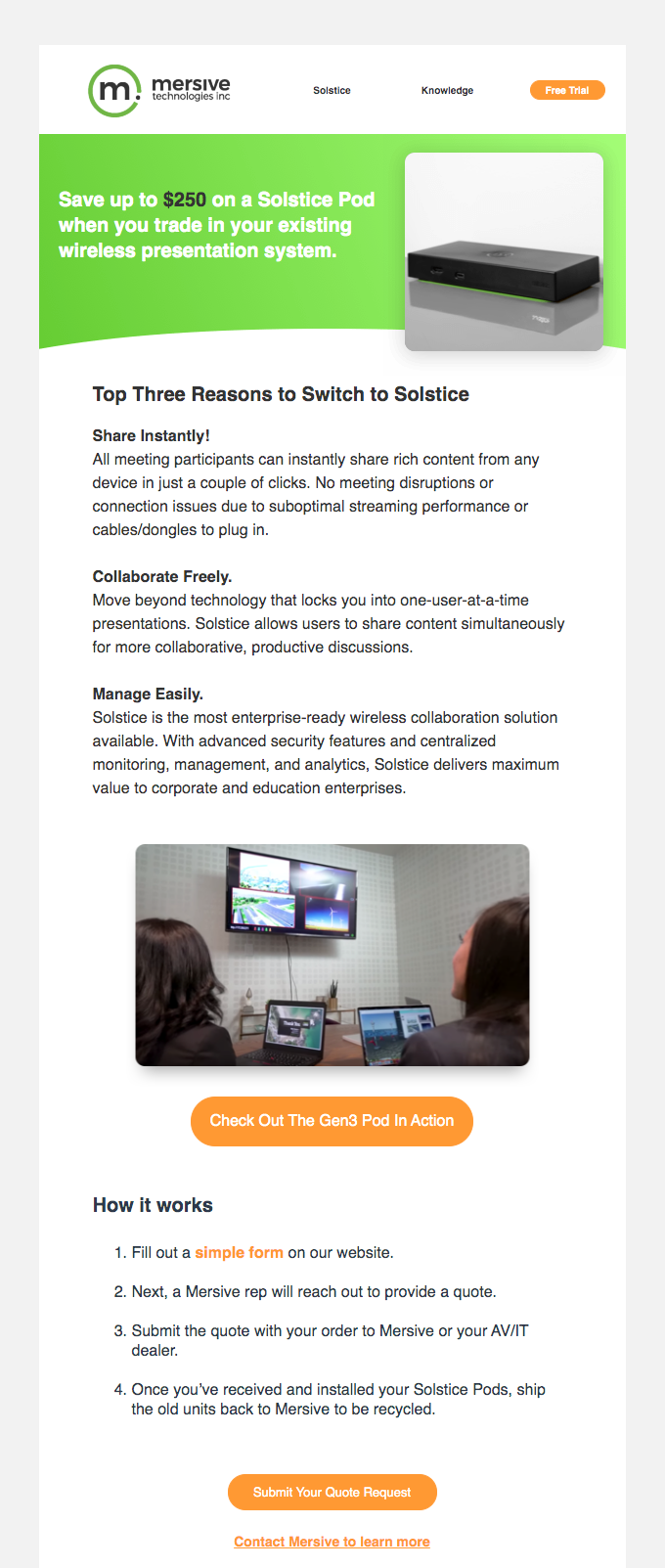
While they’re highlighting up to $250 in savings in this email, they’re also pointing out the top 3 reasons to switch over to their service.

Sure, it seems to be a combination of emails #4 and #6. But you can use a similar technique just by quickly reiterating what makes you different from the rest.
Who knows? With your deal, this could be the final push your audience needs to sign up.
Other Advanced Tactics for Your Email Marketing Funnel
Alright, now you know how to build both a beginner’s and an upgraded email marketing funnel.
Let’s check out now some advanced tactics you can use to boost conversions even higher.
There are 3 advanced tactics I’m going to point out specifically: lead scoring, audience segmentation (or “bucketing”), and creating subsequent email sequences.
Lead Scoring:
If the site visitor opens an email or clicks a link, this can be used to score a lead (usually on a scale of 1 to 5 stars, 5 meaning a highly qualified lead).
A low-scoring subscriber who seems less interested needs more time and more nurturing.
But a high-scoring lead means they will be more likely to respond to your offers since they’re further along the buyer’s journey.
Many email marketing tools like ActiveCampaign or Mailchimp handle all the lead scoring for you automatically.
Bucketing:
Similar to lead scoring, bucketing your audience is all about separating out different subscribers so you can send them more personalized content and get them closer to a sale.
For instance, a lead who entered your email marketing sales funnel while reading a blog about email list building may be much more interested in that topic than, say, copywriting best practices.
So in order to increase engagement and boost your conversion rate with them, you may want to point to other resources based on email list building.
In fact, we do the same thing with our own subscribers by asking what their biggest marketing challenge is before subscribing.
See?

Creating Subsequent Email Sequences:
Finally, you can also build out subsequent email sequences that actually branch off of your email marketing funnel.
A few places you may want to consider attaching new sequences are:
- If your subscriber is not engaging with your content (create a re-engagement sequence)
- If your subscriber has already purchased your product (create a nurture sequence)
- If your subscriber has purchased and continues to engage (create an upsell sequence)
When you branch off to other sequences, you can add even more personalization to your emails.
Plus, you can also nurture current customers into buying product upsells which can be an enormous source of revenue when done right.
One great example of how branching off to other email sequences works comes from the advanced version of our Ultimate Sales Funnel Template.
Have a look at it below.

Conclusion
So there you have it!
Creating your very own email marketing funnel doesn’t have to be complex. It doesn’t have to take days or weeks to do. And it isn’t rocket science—far from it.
With just a little elbow grease, some determination, and the right expert guidance *ahem*, you can have your email funnel up and running in no time.
All you have to do is remember:
- To fuel your funnel with quality subscribers using opt-in forms, lead magnets, or demos/webinars.
- Follow the first half of our VACUUM formula starting out (Value, Authority, Call-to-Action).
- Expand to the second half further down the road (Unique, Urgency, Make a Decision!).
- Take advantage of more “advanced” tactics later on like bucketing your subscribers, scoring leads based on engagement, and creating more complicated follow-up sequences.
And of course, always, always, always follow the main tenet of good email marketing: add value to each of your subscribers’ lives with every email.
Because if your audience isn’t getting anything out of your emails, they sure as hell aren’t going to keep clicking open.
And if you want to automate all of your marketing (including your upselling strategy) and operations needs, we’re launching a new product and under a new brand: Growbo.
Growbo is your AI team to handle all your marketing (i.e.: your email marketing funnel) and business ops needs—at a fraction of the cost and with no hiring headaches.
Learn more here or join our waitlist so that you can be one of the first to automate your growth with Growbo.
So, now that you know how to build your own email marketing funnel, are you going to take action?
Was the information in this guide helpful in getting you started?
What questions do you still have about the process that you’d like to get answered?
Let me know in the comments below.
And as always,
Keep funnelin’, stay focused.

Image Credits:
1. https://sixfigureideas.com/wp-content/uploads/2014/10/simple-email-funnel.png
2. https://uplandsoftware.com/adestra/resources/report/
3. https://www.singlegrain.com/digital-marketing/what-is-digital-marketing/
4. https://econsultancy.com/reports/email-census/
5. https://sleeknote.com/blog/social-proof-email-examples
6. https://reallygoodemails.com/emails/time-to-create-a-welcome-series-that-gets-results/
7. https://reallygoodemails.com/emails/what-makes-the-perfect-tee/
8. https://reallygoodemails.com/emails/do-you-know-what-youre-getting-into/
9. https://reallygoodemails.com/emails/its-here-dog-food-you-can-feel-good-about/
10. https://reallygoodemails.com/emails/get-50-off-your-remarkable-paper-tablet/
11. https://reallygoodemails.com/emails/shop-the-limited-last-chance-to-buy-event-while-you-can/
12. https://reallygoodemails.com/emails/buy-a-mac-or-ipad-for-college-get-beats-and-more/
13. https://reallygoodemails.com/emails/save-up-to-250-per-room-when-you-switch-to-solstice/

